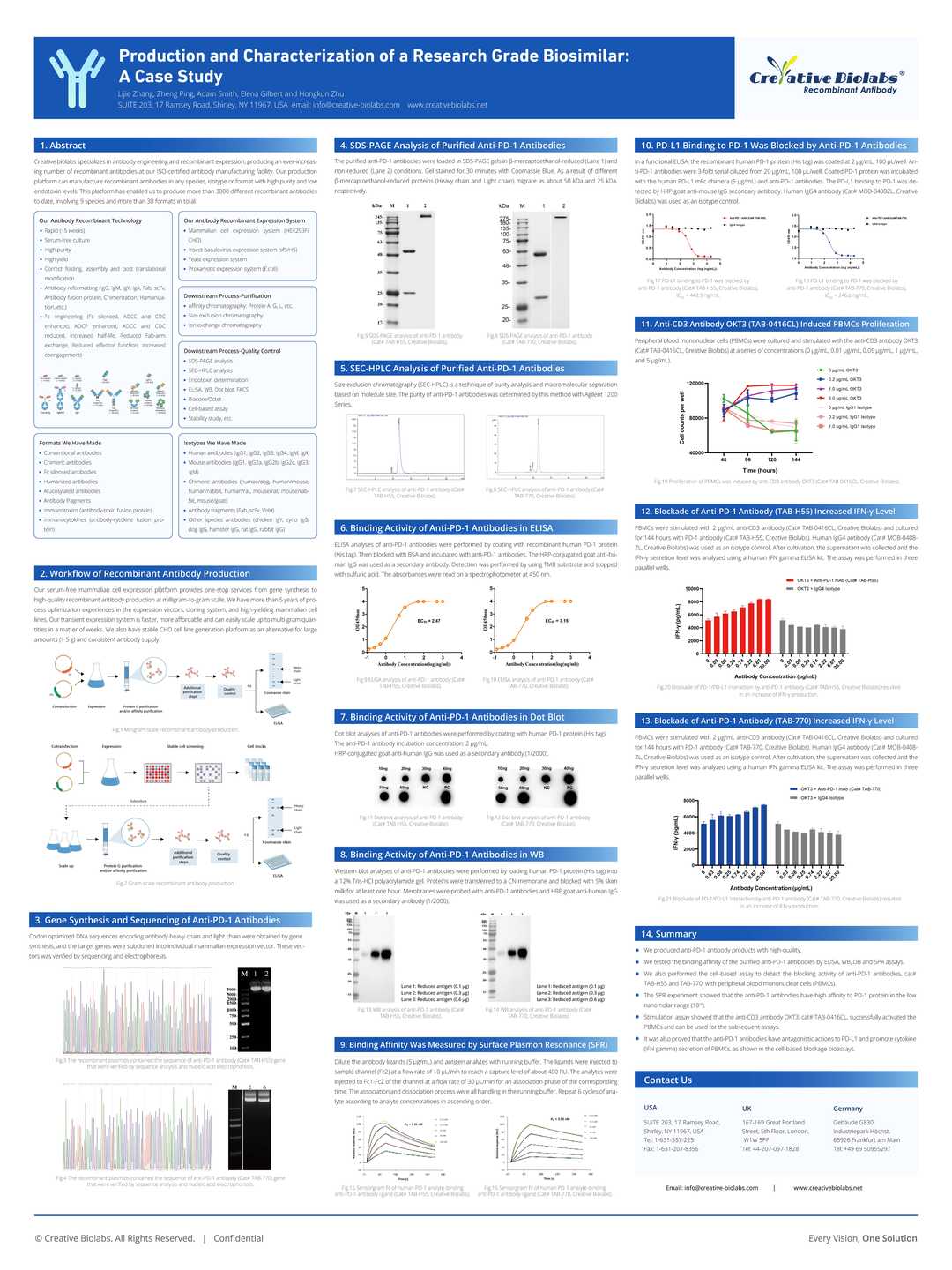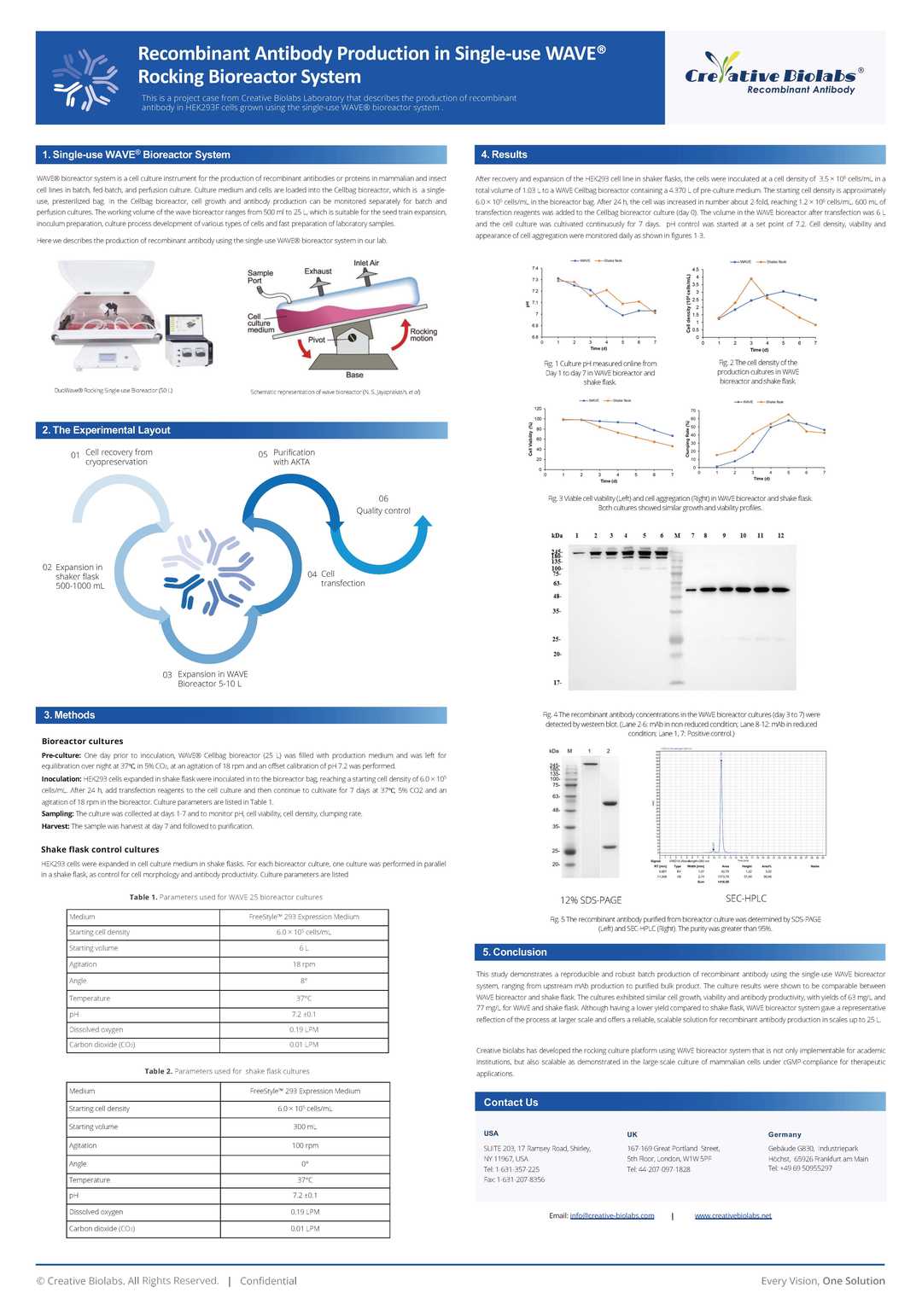Recombinant Mouse Anti-IAV HA Antibody (HC19)
CAT#: PABW-077
Recombinant Mouse Antibody (HC19) is capable of binding to IAV HA, expressed in Chinese Hamster Ovary cells (CHO).










Specifications
- Immunogen
- H3N2 IAV hemagglutinin
- Host Species
- Mouse
- Derivation
- Mouse
- Type
- IgG
- Specificity
- Tested positive against native IAV HA
- Species Reactivity
- H3N2 IAV
- Clone
- HC19
- Applications
- Can be useful in applications such as: Neutralization
Product Property
- Purity
- >95% by SDS-PAGE and HPLC analysis
- Storage
- Store the antibody (in aliquots) at -20°C. Avoid repeated freezing and thawing of samples.
Target
Customer Review
There are currently no Customer reviews or questions for PABW-077. Click the button above to contact us or submit your feedback about this product.
Cite This Product
To accurately reference this product in your publication, please use the following citation information:
(Creative Biolabs Cat# PABW-077, RRID: AB_3714201)
Submit Your Publication
Published with our product? Submit your paper and receive a 10% discount on your next order! Share your research to earn exclusive rewards.
Downloadable Resources
Download resources about recombinant antibody development and antibody engineering to boost your research.
Product Notes
This is a product of Creative Biolabs' Hi-Affi™ recombinant antibody portfolio, which has several benefits including:
• Increased sensitivity
• Confirmed specificity
• High repeatability
• Excellent batch-to-batch consistency
• Sustainable supply
• Animal-free production
See more details about Hi-Affi™ recombinant antibody benefits.
Datasheet
MSDS
COA
Certificate of Analysis LookupTo download a Certificate of Analysis, please enter a lot number in the search box below. Note: Certificate of Analysis not available for kit components.
See other products for "Clone HC19"
- CAT
- Product Name
See other products for "IAV HA"
Select a product category from the dropdown menu below to view related products.
| CAT | Product Name | Application | Type |
|---|---|---|---|
| NABG-078 | Recombinant Anti-IAV HA VHH Single Domain Antibody | FC, CA, IP, FuncS | Llama VHH |
| HPAB-0344CQ | Recombinant Llama Anti-IAV HA Single Domain Antibody (HPAB-0344CQ) | ELISA, Neut | Llama VHH |
| HPAB-0345CQ | Recombinant Llama Anti-IAV HA Single Domain Antibody (HPAB-0345CQ) | ELISA, Neut | Llama VHH |
| CAT | Product Name | Application | Type |
|---|---|---|---|
| TAB-H33 | Anti-IAV HA Recombinant Antibody (Firivumab) | FC, IP, ELISA, Neut, FuncS, IF, ICC | IgG1 - kappa |
| TAB-027ML | Anti-IAV HA Recombinant Antibody (TAB-027ML) | ELISA, IHC, FC, IP, IF, FuncS | IgG1, κ |
| TAB-438CQ | Anti-IAV HA Recombinant Antibody (TAB-438CQ) | ELISA, IHC, FC, IP, IF, BL | IgG1, κ |
| CAT | Product Name | Application | Type |
|---|---|---|---|
| MRO-2168CQ | Recombinant Mouse Anti-IAV HA Antibody (MRO-2168CQ) | WB, IF, IP, IHC-P, IHC-Fr | Mouse antibody |
| MRO-2169CQ | Recombinant Mouse Anti-IAV HA Antibody (VC167) | ELISA | Mouse antibody |
| MRO-2170CQ | Recombinant Mouse Anti-IAV HA Antibody (1E6A7) | WB, ELISA | Mouse antibody |
| MRO-2171CQ | Recombinant Mouse Anti-IAV HA Antibody (7B9B2) | WB, ELISA | Mouse antibody |
| MRO-2172CQ | Recombinant Mouse Anti-IAV HA Antibody (FB75) | Neut, ELISA | Mouse antibody |
| CAT | Product Name | Application | Type |
|---|---|---|---|
| EPAF-0652CQ | Recombinant Mouse Anti-IAV HA Antibody (pSAN13.4.1) | ELISA | IgG |
| CAT | Product Name | Application | Type |
|---|---|---|---|
| HPAB-0682-CN-F(E) | Human Anti-IAV HA Recombinant Antibody; Fab Fragment (HPAB-0682-CN-F(E)) | ELISA, Neut | Human Fab |
| HPAB-0406-WJ-F(E) | Human Anti-IAV HA Recombinant Antibody; Fab Fragment (HPAB-0406-WJ-F(E)) | ELISA | Human Fab |
| HPAB-0407-WJ-F(E) | Human Anti-IAV HA Recombinant Antibody; Fab Fragment (HPAB-0407-WJ-F(E)) | ELISA | Human Fab |
| FAMAB-0204WJ-F(E) | Mouse Anti-IAV HA Recombinant Antibody (clone H5.16); Fab Fragment | ELISA, WB, Neut | Mouse Fab |
| FAMAB-0205WJ-F(E) | Mouse Anti-IAV HA Recombinant Antibody (clone H5.22); Fab Fragment | ELISA, WB, Neut | Mouse Fab |
| CAT | Product Name | Application | Type |
|---|---|---|---|
| HPAB-0019-WJ-S(P) | Human Anti-IAV HA Recombinant Antibody; scFv Fragment (HPAB-0019-WJ-S(P)) | ELISA | Human scFv |
| PSBC-393 | Recombinant Human Anti-IAV HA Antibody scFv Fragment (PSBC-393) | ELISA, Neut | Human scFv |
| PSBC-426 | Human Anti-IAV HA Recombinant Antibody; scFv Fragment (PSBC-426) | ELISA, Neut | Human scFv |
| PSBC-488 | Recombinant Human Anti-IAV HA Antibody scFv Fragment (PSBC-488) | ELISA, Neut | Human scFv |
| HPAB-0304-WJ-S(P) | Human Anti-IAV HA Recombinant Antibody; scFv Fragment (HPAB-0304-WJ-S(P)) | Neut | Human scFv |
| CAT | Product Name | Application | Type |
|---|---|---|---|
| AFC-TAB-027ML | Afuco™ Anti-IAV HA ADCC Recombinant Antibody, ADCC Enhanced (AFC-TAB-027ML) | ELISA, IHC, FC, IP, IF, FuncS | ADCC enhanced antibody |
| AFC-TAB-438CQ | Afuco™ Anti-IAV HA ADCC Recombinant Antibody, ADCC Enhanced (AFC-TAB-438CQ) | ELISA, IHC, FC, IP, IF, BL | ADCC enhanced antibody |
| AFC-TAB-H33 | Afuco™ Anti-IAV HA ADCC Recombinant Antibody, ADCC Enhanced (AFC-TAB-H33) | FC, IP, ELISA, Neut, FuncS, IF | ADCC enhanced antibody |
| CAT | Product Name | Application | Type |
|---|---|---|---|
| FAMAB-0219WJ | Human Anti-IAV HA Recombinant Antibody (clone 16D11) | ELISA, WB, Neut | Human IgM |
| CAT | Product Name | Application | Type |
|---|---|---|---|
| VS-0424-XY118 | AbPlus™ Anti-IAV HA Magnetic Beads (D1-1) | IP, Protein Purification |
| CAT | Product Name | Application | Type |
|---|---|---|---|
| VS-0325-FY191 | Human Anti-IAV HA (clone 3E1) scFv-Fc Chimera | ELISA, Neut | Human IgG1, scFv-Fc |
| CAT | Product Name | Application | Type |
|---|---|---|---|
| VS-0625-XY50 | Human Anti-IAV HA Vaccinal Antibody (VS-0625-XY50) | ELISA, Neut | Human IgG |
| VS-0625-XY51 | Human Anti-IAV HA Vaccinal Antibody (VS-0625-XY51) | ELISA, BLI, Neut | Human IgG |
| VS-0625-XY52 | Human Anti-IAV HA Vaccinal Antibody (VS-0625-XY52) | ELISA, BLI, Neut | Human IgG |
| VS-0625-XY53 | Human Anti-IAV HA Vaccinal Antibody (VS-0625-XY53) | BLI, Neut | Human IgG |
Popular Products

Application: Neut, ELISA, IF, IP, FuncS, FC, ICC

Application: IF, IP, Neut, FuncS, ELISA, FC, WB

Application: WB, Neut, ELISA, IF, IP, FuncS, FC

Application: Neut, Inhib, FC, ELISA

Application: Neut, FC

Application: ELISA, IHC, FC, IP, IF, FuncS

Application: Neut, FuncS, IHC, ELISA, FC, Inhib
For research use only. Not intended for any clinical use. No products from Creative Biolabs may be resold, modified for resale or used to manufacture commercial products without prior written approval from Creative Biolabs.
This site is protected by reCAPTCHA and the Google Privacy Policy and Terms of Service apply.






























